TO
| Title | Date | Subject | Description | ||
|---|---|---|---|---|---|
| 1 |
 |
"Regulatory and analyzer update for USEPA's new formaldehyde emissions limit for combustion turbines" | 2019 | Spectrum's technical team has demonstrated a <27 ppbvd Formaldehyde detection limit (DL) on its extractive FTIR equipped using a 5-meter cell pathlength. This formaldehyde detection is well below USEPA's 91 ppbvd emission threshold for Combustion Turbines now subject to regulation under NESHAP Subpa... | |
| 2 |
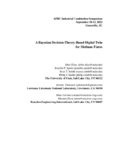 |
A bayesian decision-theory-based digital twin for methane flares | 2022 | Ground flares operate in a high-turndown, standby configuration for a significant portion of their operating life, being fully utilized only under process upset scenarios or emergencies. The low-momentum flow results in poor fuel-air mixing near the flare tip, leading to decreased overall combustion... | |
| 3 |
 |
A chemical kinetics approach for heavy fuel oils gasification modelling | 2022 | surrogate; HFOs; pyrolysis; chemical kinetics modeling; Gassification | Refinery oil residue commonly considered the bottom of the barrel, can no longer be a waste. The increasing energy demand and the constant depletion of light oil supply make it crucial to find a suitable way to convert residual oils into valuable fuels. The gasification process represents a possible... |
| 4 |
 |
A volume of fluid approach to model injection of highly viscous fluids | 2022 | Despite the transition to renewable energy sources, fossil fuels will still play a significant role in satisfying the world's energy needs shortly. In addition, the rise in the demand for light distillates and the depletion of light crude oil reservoirs are shifting the interest toward the conversio... | |
| 5 |
 |
Advanced emissions monitoring from elevated gas flares for early warning system and optimization of plant operations | 2019 | Real-time monitoring of emissions from elevated gas flares is very difficult and expensive due to the relative location of the source and the cost to collect samples for analysis. Elevated Analytics has developed and applied a UAV based sensor system to accomplish this task. Besides providing a snap... | |
| 6 |
 |
The advantages of monitoring flare pilots with instantaneous response | 2020 | This paper will discuss applications for and details of a fiber optic pilot monitoring system that addresses known, specific challenges in the market. For decades, thermocouples have been the most widely accepted device for determining flare pilot status. However, there is a growing desire in the in... | |
| 7 |
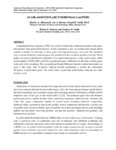 |
An air-assisted flare for biomass gasifiers | 2019 | Computational fluid dynamics (CFD) was used to simulate the combustion practice of the gases that produce from gasification process. In this simulation a new air-assisted flare design which capable to handle low flowrates of these gases with high performance was used. The simulated cases were perfor... | |
| 8 |
 |
Analysis of burner operation inside an enclosed ground flare | 2022 | Thermo-Acoustic Coupling; Enclosed Flare; LES CFD Model; Noise; Premixed Burner | An industrial enclosed ground flare used as part of a large refinery project has been analyzed to assess combustion stability and performance under low and high flow conditions. This flare includes a large combustion chamber directly above the burner deck with Low Flow (LF) burners that fire up to 9... |
| 9 |
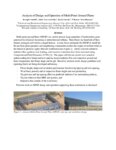 |
Analysis of design and operation of multi-point ground flares | 2022 | Multi-point ground flares (MPGF) are used to process large quantities of hydrocarbon gases generated in chemical processing or petrochemical refining. These flares use hundreds of flare burners arranged and fired in a staged fashion. A wind fence surrounds the MPGF to shield the flames from plant op... | |
| 10 |
 |
Capturing the effect of near-and far-field dynamics on the combustion efficiency of multi-point ground flares | 2022 | Multi-point ground flares are frequently used in scenarios where flare gas flow rates can be high and pollution (noise, light, smoke) needs to be minimized. We have applied Arches, a large eddy simulation (LES) tool that we have developed for capturing the dynamics of flares (turbulent mixing, local... | |
| 11 |
 |
CFD development for fired heater applications | 2022 | Industry values the ability to ‘virtually' verify and optimize burner performance through CFD simulation and to evaluate the suitability of burner and furnace designs. Inaccurate results may lead us to falsely reject good burner designs or accept a poor design. Field problems can be far more expen... | |
| 12 |
 |
Clearing the Path | 2018-01 | Student success; University of Utah | A strategic student success agenda. |
| 13 |
 |
Clearsign core process burners and boiler burners - burner scaling and field results | 2022 | During previous AFRC Industrial Combustion Symposia, ClearSign Technologies Corporation introduced its ClearSign Core technology currently used in our Ultra Low NOx burner products. These ClearSign Core products have now been developed for different types of equipment applications to meet stringent ... | |
| 14 |
 |
Effect of operating parameters on fired heater tube skin temperature measurement accuracy & the development of new improved tube skin thermocouple | 2022 | Refineries are often faced with challenges to meet production target, improve efficiency, process opportunity crudes with limited information on fouling characteristics etc. The common parameter that often becomes constraining are the tube skin temperatures which are critical in maintaining the inte... | |
| 15 |
 |
Experimental investigation for the development of burners for low scale reheating of semi-finished metal products | 2019 | recuperative burner; fuel rich combustion; direct fired furnace; scale reduction; radiant tube | Industrial furnaces for the reheating of semi-finished metal products are often direct fired with natural gas and air. Oxidation of the metals exposed to the furnace atmosphere causes significant material losses and additional work during furnace operation and in further processing. A reheating conc... |
| 16 |
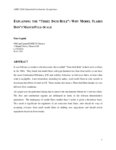 |
Explaining the "three inch rule": why model flares don't match full-scale | 2022 | It was Pohl and co-workers who discovered the so-called "Three Inch Rule" in their work on flares in the 1980s. They found that model flares with pipe diameter less than three inches do not have the same Combustion Efficiency (CE) and stability behaviour as full-scale flares, at least when wind is n... | |
| 17 |
 |
Flare combustion index in lieu of combustion zone net heating value | 2020 | Flares are commonly used at industrial facilities (e.g., oil and gas extraction and production sites, gas processing plants, oil refineries, and petrochemical manufacturing plants) to safely dispose of process waste gases. Waste gases may be produced due to process upset or because they are unrecove... | |
| 18 |
 |
Flare regulatory update | 2019 | The United States Environmental Protection Agency (USEPA) revised the regulations for the refinery through the Refinery Sector Rule (RSR) revisions to NESHAP CC and UUU (aka MACT CC and MACT UUU). The USEPA is expected to propose revisions to the Ethylene MACT and the Hazardous Organic NESHAP (HON) ... | |
| 19 |
 |
Installation of lean premix and remote fuel staging system in industrial process heater for next generation nox emissions control | 2022 | John Zink Hamworthy Combustion (JZHC) has completed the first installation and startup of the SOLEX combustion system in the Vacuum Tower Feed Furnace at a GS Caltex refinery in South Korea. The patented SOLEX™ burner compromises a lean premix zone of combustion, where the air-to-fuel ratio (AFR) ... | |
| 20 |
 |
Investigative approach to address thermoacoustic vibration in gas-fired heaters and boilers | 2022 | Industrial gas-fired boilers, furnaces and heaters occasionally encounter low-frequency vibrations generated by dynamic feedback between the burner (or burners) and acoustic modes in adjacent cavities in the main combustion chamber or ductwork. Feedback occurs when pressure pulses associated with ac... | |
| 21 |
 |
Multistage flameless oxidation | 2019 | Flameless Oxidation (FLOX®) is a well established low thermal NOx combustion method since the early 1990s. Flameless Oxidation can be applied for processes above self ignition temperature. Typically, switching between flame- and FLOX-mode occurs at a temperature of 850°C. This restriction can be o... | |
| 22 |
 |
Neutron imaging of heterogeneous solid fuels under heating | 2019 | Solid-fuel pyrolysis, gasification, and combustion continue to play an important role in the industrial and utility sectors. Behavior of heterogeneous fuels such as biomass (e.g., wood and grasses), municipal solid waste (MSW), and coal is less understood on the micro than the macro scales, particul... | |
| 23 |
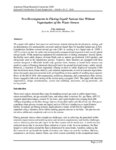 |
New developments in flaring liquid natural gas without vaporization of the waste stream | 2020 | This paper will explore best practices and lessons learned during the development, testing, and implementation of a mechanically atomized multi-jet liquid flare for liquified natural gas (LNG). Liquefaction facilities convert natural gas into LNG by cooling it to a liquid state at -259⁰F (- 162⁰... | |
| 24 |
 |
Numberical and experimental investigations on an innovative, regeneratively heated radiant tube with compact dimensions | 2019 | heat treatment; radiant tube; regenerative heating; staged combustion | The presented, public funded research cooperation project of the Department for Industrial Furnaces and Heat Engineering at the RWTH Aachen University and the WS Wärmeprozesstechnik GmbH main aim is the development of an innovative, regeneratively heated radiant tube with compact dimensions. The ma... |
| 25 |
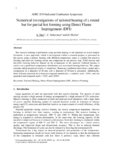 |
Numerical investigations of tailored heating of a round bar for partial hot forming using Direct Flame Impingement (DFI) | 2019 | Tailored Heating; Direct Flame Impingement (DFI); Massive Forming | Hot massive forming is performed using uniform heating of the materials to avoid wrinkle formation. A new approach, which is investigated within a research project, is presented in this paper, using a tailored heating with different temperature zones to conduct hot massive forming and semi-hot formi... |
